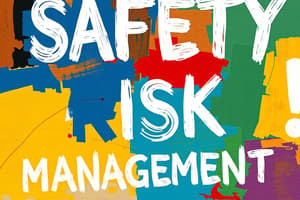Podcast
Questions and Answers
Which type of safety emphasizes individual protection from physical harm?
Which type of safety emphasizes individual protection from physical harm?
- Environmental Safety
- Occupational Safety
- Public Safety
- Personal Safety (correct)
What is the primary aim of occupational safety?
What is the primary aim of occupational safety?
- Ensuring safe work environments (correct)
- Providing individual security measures
- Protecting the environment from pollution
- Preparing for public emergencies
Which principle of safety involves identifying hazards and assessing risks?
Which principle of safety involves identifying hazards and assessing risks?
- Prevention
- Emergency Preparedness
- Training and Education
- Risk Assessment (correct)
What does the term 'hazard' refer to in the context of safety?
What does the term 'hazard' refer to in the context of safety?
Which common safety practice focuses on maintaining and inspecting safety equipment?
Which common safety practice focuses on maintaining and inspecting safety equipment?
What is the purpose of safety culture within an organization?
What is the purpose of safety culture within an organization?
Which of the following is NOT a component of emergency preparedness?
Which of the following is NOT a component of emergency preparedness?
What measures are involved in environmental safety?
What measures are involved in environmental safety?
What is emphasized by implementing safety equipment such as helmets and gloves?
What is emphasized by implementing safety equipment such as helmets and gloves?
Which aspect of safety involves compliance with regulations such as OSHA?
Which aspect of safety involves compliance with regulations such as OSHA?
Flashcards are hidden until you start studying
Study Notes
Definition of Safety
- Condition of being protected from harm or injury.
- Involves measures and practices to prevent accidents and reduce risks.
Types of Safety
-
Personal Safety
- Individual protection from physical harm.
- Involves self-defense, awareness, and emergency preparedness.
-
Occupational Safety
- Ensuring safe work environments.
- Involves adherence to regulations and use of safety equipment.
-
Public Safety
- Protection of the general public from crime, disasters, and emergencies.
- Involves law enforcement, emergency services, and disaster relief.
-
Environmental Safety
- Protection of the environment from hazardous substances and practices.
- Involves regulations on pollution and waste management.
Principles of Safety
-
Risk Assessment
- Identify hazards, assess risks, and implement control measures.
-
Prevention
- Implement proactive measures to eliminate or minimize risks.
-
Training and Education
- Regular training for individuals on safety protocols and emergency procedures.
-
Safety Equipment
- Use of personal protective equipment (PPE) such as helmets, gloves, and masks.
-
Emergency Preparedness
- Creating and practicing emergency response plans.
Key Concepts
-
Hazard vs. Risk
- Hazard: A potential source of harm.
- Risk: Likelihood of harm occurring from a hazard.
-
Safety Culture
- Organization's commitment to safety at all levels.
- Encourages open communication about safety issues.
Importance of Safety
- Protects individuals from injuries and fatalities.
- Reduces financial losses due to accidents.
- Enhances quality of life and productivity.
- Fosters trust and reliability in organizations.
Common Safety Practices
- Regular safety audits and inspections.
- Maintenance of safety equipment.
- Implementation of safety signage and protocols.
- Encouragement of reporting unsafe conditions or behavior.
Legal Considerations
- Compliance with safety regulations (e.g., OSHA in the U.S.).
- Liability in case of accidents due to negligence.
- Importance of documentation and incident reporting.
Definition of Safety
- Safety refers to the condition of being shielded from harm or injury.
- Incorporates various measures and practices aimed at preventing accidents and mitigating risks.
Types of Safety
- Personal Safety
- Focuses on individual protection from physical harm.
- Involves skills like self-defense, situational awareness, and preparation for emergencies.
- Occupational Safety
- Strives to create safe workplaces.
- Emphasizes compliance with safety regulations and the proper use of safety equipment.
- Public Safety
- Aims to protect the community from crime, disasters, and emergencies.
- Involves roles of law enforcement, emergency services, and disaster management.
- Environmental Safety
- Protects the environment from harmful substances and practices.
- Includes regulations related to pollution control and effective waste management.
Principles of Safety
- Risk Assessment
- Involves identifying hazards, evaluating risks, and implementing appropriate control measures.
- Prevention
- Focuses on proactive strategies to eliminate or reduce risks before they cause harm.
- Training and Education
- Ensures individuals receive regular training on safety protocols and emergency procedures.
- Safety Equipment
- Promotes the use of personal protective equipment (PPE) such as helmets, gloves, and respiratory masks.
- Emergency Preparedness
- Involves the creation and practice of emergency response plans to ensure readiness.
Key Concepts
- Hazard vs. Risk
- Hazard is identified as a potential source of harm.
- Risk pertains to the likelihood of harm occurring as a result of a hazard.
- Safety Culture
- Reflects an organization's overall dedication to safety at every level.
- Cultivates an environment that encourages open communication regarding safety concerns.
Importance of Safety
- Essential for protecting individuals from injuries and fatalities.
- Contributes to the reduction of financial losses associated with accidents.
- Enhances overall quality of life and boosts productivity.
- Builds trust and reliability in organizations among employees and clients.
Common Safety Practices
- Conducting regular safety audits and inspections to identify potential hazards.
- Ensuring ongoing maintenance of safety equipment to keep it functional.
- Implementing safety signage and clear protocols to guide behavior.
- Encouraging the reporting of unsafe conditions or behaviors to foster a safer environment.
Legal Considerations
- Necessitates compliance with safety regulations, such as OSHA guidelines in the United States.
- Addresses liability concerns in cases of accidents occurring from negligence.
- Highlights the importance of documentation and thorough incident reporting for accountability and improvement.
Studying That Suits You
Use AI to generate personalized quizzes and flashcards to suit your learning preferences.




